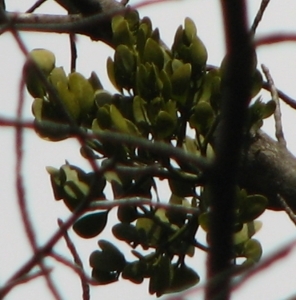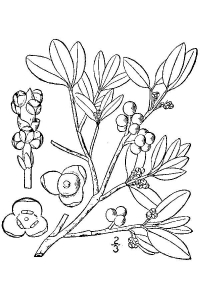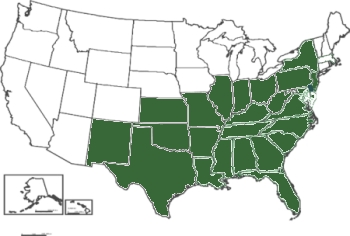Phoradendron leucarpum
 |
 |
Photo courtesy Renee Brecht |
Britton & Brown |
| Botanical name: | Phoradendron leucarpum |
| Common name: | American Mistletoe, Oak Mistletoe |
| Group: | dicot |
| Family: | Viscaceae |
| Growth type: | Shrub; sub-shrub |
| Duration: | perennial |
| Origin: | native |
| Plant height: | 1 - 2' |
| Foliage: | evergreen, opposite, oblong to obovate, thick, leathery, 1/2" to 2" |
| Flower: | inconspicuous, unisexual, in short spikes from leaf axils. Male and female flowers on separate plants |
| Flowering time: | Blooms September 15-October 25; fruit matures during November of the following year, remaining on the branches well through the winter (Stone, p. 417) |
| Habitat: | Generally found on Nyssa sylvatica in New Jersey, with reports of some on Acer rubrum. One unsubstantiated record of Quercus alba as the host plant exists in NJ. |
| Range in New Jersey: | According
to Witmer Stone, formerly frequently found through much of the Middle district
and occasional on the edge of the Pine barrens, but now nearly
exterminated in the State. Monmouth County was the most northern known
station for the plant. According to Joe Arsenault, most of the remaining mistletoe is concentrated with in the Maurice River basin, the the Great Egg Harbor River basin, and the Mullica River basin. (3/08) |
| Heritage ranking, if any: | S2; LP; HL |
| Distribution: |  |
| Misc. | P. leucarpum is
a hemiparasite; that is, drawing minerals and water from its host tree,
but it retains the ability to produce its own chlorophyll. Its host
tree varies widely throughout the United States, but in New Jersey is
found almost exclusively on Acer rubrum. P. leucarpum is the larval host for the Great Purple Hairstreak in some areas of the country. Grouse, mourning doves, bluebirds, evening grosbeaks, robins, and pigeons will all feed on American mistletoe. When the growth of the mistletoe is dense and forms a "witches' broom", it may be used as nesting by various birds, including various spotted owls, "great gray owls, long-eared owls, goshawks, and sharp-shinned hawks. Likewise, some migratory birds also nest in witches’ broom — gray jay, northern beardless-tyrannulet, red crossbills, house wrens, mourning doves, pygmy nuthatches, chickadees, Western tanagers, chipping sparrows, hermit thrushes, Cassin’s finches, and pine siskins." Red squirrels and flying squirrels will sometimes use the witches broom as cover as well. (USGS) It is thought that mistletoe spreads by birds feeding on the berries, after they have passed through the birds, and also by Its nectar is used by various bees and it is pollinated by various insects including certain ants, flies, and beetles (See USGS link above). Phoradendron means "thief in a tree". The entymology of "mistletoe" is thought to be German, "mist" or "dung" and "tang", "branch"--literally, "dung on a branch". |